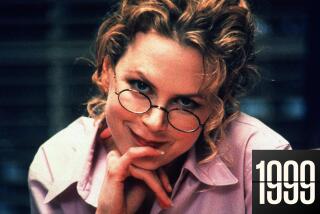HE MAKES IT LOOK PICTURE-PERFECT
- Share via
POLISH-BORN cinematographer Janusz Kaminski has shot every Steven Spielberg film since 1993’s Oscar-winning “Schindler’s List,” for which the visual artist won his first Academy Award for the atmospheric black-and-white cinematography.
Five years later, Kaminski picked up his second Oscar for bringing the invasion of Normandy to life in “Saving Private Ryan.”
And the two collaborators just completed next year’s “Indiana Jones and the Kingdom of the Crystal Skull.”
Somewhere in between all that, Kaminski managed to produce some of his most evocative, expressionistic work -- in Julian Schnabel’s haunting drama, “The Diving Bell and the Butterfly,” which opens Nov. 30.
Based on the bestselling memoir of Jean-Dominique Bauby, a.k.a. Jean-Do, the film revolves around the jet-setting editor of French Elle, who at 43 suffered a massive stroke and thereafter was able to communicate only by blinking his left eye. Kaminski’s camera becomes Jean-Do’s blinking eye, giving audiences what the man’s life and impressions were in his paralyzed state. Is collaborating with Julian Schnabel, who is an artist turned director, different than working with a traditional filmmaker like Steven Spielberg?
Julian, because he is an artist, has a totally different point of view and interests. Such as?
He is as much interested in what’s happening with the texture of the scene while the actors are talking as he is interested in what the actors are saying. Because he is an artist, there is a certain lack of patience or disinterest looking at the same thing over and over again. We never did the same take twice. If we did one take where we were panning the camera off to the right, the other take we would be panning off to the left or tilting down. . . . That was very liberating to some degree.
I am always interested in what happens when a person is talking [on screen]. While you are talking, I may go from your face to your hand or maybe you will touch something and I’ll follow that and then I’ll find your face again. Working with him was just an extension of my desires. When I was in film school, I shot a tremendous amount of film for younger filmmakers, classmates. I would always start at the face, then look around and come back. The camera is subjective in the movie because it reflects what Jean-Do sees. How did you achieve that?
The camera became, as you know, almost an actor. When the actors are performing, they are performing to the camera and I happen to be reflecting what the actor [Mathieu Amalric, who plays Jean-Do] is feeling and what he is seeing. We did a series of tests where I would play with various devices that would allow me to deconstruct the image to make it out of focus, allow me to come in really close and be sharp and then go out of focus. A lot of that happened in preproduction where I would sit [he covers one eye] and see what would happen. What is the world looking like [through just one eye]? So how do I do it? What is the technique?
There’s an optical system called swing and shift borrowed from still photographers and used frequently in commercials. I started playing with that. You can focus on a wall straight on and selectively choose what you want in focus. So as I am looking at you, I can focus only on your eye and then everything else can go out of focus. It is a brilliant innovation. You are twisting the lens and you are twisting the perspective and thus you can focus on very specific places. How did you achieve the blinking and the stark flashes of white light when Jean-Do emerges from his coma?
Sometimes, as you are blinking, you blink real fast and sometimes you do it really slow. So all that stuff contributed to what Jean-Do must have been looking at in terms of his inability to focus, his brain not functioning at first really fast and the colors blending. What I would do is I would put a little Vaseline on the lens and would play with the shutter degree and camera speed . . . and the image would get a little bit smeared.
Can you talk about the color palette?
I felt the movie should be a little bit de-saturated, kind of almost turquoise like the ocean. Julian actually did a beautiful job choosing the color of the hospital room. He dressed the room. He wanted the walls to be covered with memoirs of his life. He chose the pajama colors of Jean-Do. [In the flashbacks] the colors are warmer because that is kind of his memory. It was more vivid.
More to Read
Only good movies
Get the Indie Focus newsletter, Mark Olsen's weekly guide to the world of cinema.
You may occasionally receive promotional content from the Los Angeles Times.











